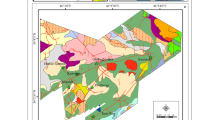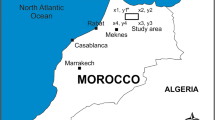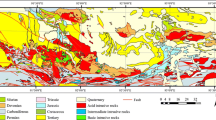This paper describes a hybrid fuzzy weights-of-evidence (WofE) model for mineral potential mapping that generates fuzzy predictor patterns based on (a) knowledge-based fuzzy membership values and (b) data-based conditional probabilities. The fuzzy membership values are calculated using a knowledge-driven logistic membership function, which provides a framework for treating systemic uncertainty and also facilitates the use of multiclass predictor maps in the modeling procedure. The fuzzy predictor patterns are combined using Bayes’ rule in a log-linear form (under an assumption of conditional independence) to update the prior probability of target deposit-type occurrence in every unique combination of predictor patterns. The hybrid fuzzy WofE model is applied to a regional-scale mapping of base-metal deposit potential in the south-central part of the Aravalli metallogenic province (western India). The output map of fuzzy posterior probabilities of base-metal deposit occurrence is classified subsequently to delineate zones with high-favorability, moderate favorability, and low-favorability for occurrence of base-metal deposits. An analysis of the favorability map indicates (a) significant improvement of probability of base-metal deposit occurrence in the high-favorability and moderate-favorability zones and (b) significant deterioration of probability of base-metal deposit occurrence in the low-favorability zones. The results demonstrate usefulness of the hybrid fuzzy WofE model in representation and in integration of evidential features to map relative potential for mineral deposit occurrence.






Similar content being viewed by others
References
Agterberg, F. P., and Cheng, Q., 2002, Conditional independence test of weights-of-evidence modeling: Natural Resources Research, v. 11, no. 4, p. 249–255.
Agterberg, F. P., Bonham-Carter, G. F., and Wright, D. F., 1990, Statistical pattern integration for mineral exploration, in Gaál, G., and Merriam, D. F., eds., Computer Applications in Resource Estimation Prediction and Assessment for Metals and Petroleum: Pergamon Press, Oxford-New York, p. 1–21.
An, P., Moon, W. M., and Rencz, A., 1991, Application of fuzzy set theory for integration of geological, geophysical and remote sensing data: Can. Jour. Exploration Geophysics, v. 27, no. 1, p. 1–11.
Bonham-Carter, G. F., 1994, Geographic Information Systems for geoscientists: modeling with GIS: Pergamon Press, Ontario, 398 p.
Bonham-Carter, G. F., and Agterberg, F. P., 1990, Application of a microcomputer-based geographic information system to mineral-potential mapping, in Hanley, J. T., and Merriam, D. F., eds., Microcomputer-based Applications in Geology, II: Pergamon Press, New York, p. 49–74.
Brown, W. M., Gedeon, T. D., Groves, D. I., and Barnes, R. G., 2000, Artificial neural networks: a new method for mineral prospectivity mapping: Australian Jour. Earth Sciences, v. 47, no. 4, p. 757–770.
Carranza, E. J. M., and Hale, M., 2001, Geologically constrained fuzzy mapping of gold mineralisation potential, Baguio district, Philippines: Natural Resources Research, v. 10, no. 2, p. 125–136.
Cheng, Q., and Agterberg, F. P., 1999, Fuzzy weights of evidence and its application in mineral potential mapping: Natural Resources Research, v. 8, no. 1, p. 27–35.
Deb, M., 1999, Metallic mineral deposits of Rajasthan, in Kataria, P., ed., Proc. Seminar on Geology of Rajasthan – Status and Perspective (Udaipur, India), p. 213–237.
Deb, M., and Sarkar, S. C., 1990, Proterozoic tectonic evolution and metallogenesis in the Aravalli-Delhi orogenic complex, NW India: Precambrian Research, v. 46, no. 1–2, p. 115–137.
Gettings, M. E., and Bultman, M. W., 1993, Quantifying favorableness for occurrence of a mineral deposit type – an example from Arizona: U. S. Geol. Survey, Open-File Rep. 93–392, 23 p.
GSI, 1981, Total intensity aeromagnetic map and map showing the magnetic zones of the Aravalli region, southern Rajasthan and northwestern Gujarat, India: Geol. Survey India, Hyderabad, India, map, scale: 1: 253,440.
Gupta, S. N., Arora, Y. K., Mathur, R. K., Iqballuddin, Prasad, B., Sahai, T. N., and Sharma, S. B., 1995a, Lithostratigraphic map of Aravalli region (2nd edn.): Geological Survey of India, Calcutta, India, map, scale: 1: 250,000.
Gupta, S. N., Arora, Y. K., Mathur, R. K., Iqballuddin, Prasad, B., Sahai, T. N., and Sharma, S. B., 1995b, Structural map of the Precambrian of Aravalli region (2nd edn.): Geological Survey of India, Calcutta, India, map, scale: 1:250,000.
Gupta, S. N., Arora, Y. K., Mathur, R. K., Iqballuddin, Prasad, B., Sahai, T. N., and Sharma, S. B., 1997, The Precambrian geology of the Aravalli Region: Geol. Survey India, Mem. v. 123, GSI, Hyderabad, India, 262 p.
Haldar, S. K., 2001, Grade-tonnage model for lead-zinc deposits of Rajasthan, India: Proc. Intern. Workshop on Sediment-hosted Lead-Zinc Deposits in the Northwestern Indian Shield (New Delhi and Udaipur, India), p. 153–160.
Heron, A. M., 1953, The geology of central Rajputana. Geol. Survey India Mem., v. 79, no. 1, 389 p.
Kemp, L. D., Bonham-Carter, G. F., and Raines, G. L., 1999, Arc-WofE: ArcView extension for weights of evidence mapping. http://gis.nrcan.gc.ca/software/arcview/wofe.
Kemp, L. D., Bonham-Carter, G. F., Raines, G. L., and Looney, C. G., 2001, Arc-SDM: ArcView extension for spatial data modelling using weights of evidence, logistic regression, fuzzy logic and neural network analysis: http://ntserv.gis.nrcan.gc.ca/sdm/.
Knox-Robinson, C. M., 2000, Vectorial fuzzy logic: a novel technique for enhanced mineral prospectivity mapping with reference to the orogenic gold mineralisation potential of the Kalgoorlie Terrane, Western Australia: Australian Jour. Earth Sciences, v. 47, no. 5, p. 929–942.
Pan, G. C., and Harris, D. P., 2000, Information synthesis for mineral exploration: Oxford Univ. Press, Inc., New York, 461 p.
Porwal, A., and Sides, E. J., 2000, A predictive model for base-metal exploration in a GIS environment: Intern. Archives Photogrammetry and Remote Sensing, v. 33, pt. B7 (Amsterdam), p. 1178–1184.
Porwal, A., Carranza, E. J. M., and Hale, M., 2003a, Extended weights-of-evidence modelling for predictive mapping of basemetal deposit potential in Aravalli Province, Western India: Exploration and Mining Geology, v. 10, no. 4, p. 155–163.
Porwal, A., Carranza, E. J. M., and Hale, M., 2003b, Knowledge-driven and data-driven fuzzy models for predictive mineral potential mapping: Natural Resources Research, v. 12, no. 1, p. 1–25.
Raja Rao, C. S., Poddar, B. C., Basu, K. K., and Dutta, A. K., 1971, Precambrian stratigraphy of Rajasthan: a review: Geol. Survey India, Records v. 101, no. 2, p. 60–79.
Roy, A. B., 1988, Stratigraphic and tectonic frame work of the Aravalli Mountain Range, in Roy, A. B., ed., Precambrian of the Aravalli Mountain Rajasthan, India: Geol. Society India Mem., v. 7, p. 3–31.
Roy, A. B., Sharma, B. L., Paliwal, B. S., Chauhan, N. K., Nagori, D. K., Golani, P. R., Bejarniya, B. R., Bhu, H., and Ali Sabah, M., 1993, Lithostratigraphic and tectonic evolution of the Aravalli Supergroup: a protogeosynclinal sequence, in Cassyap, A. M., ed., Rift Basins and Aulacogens: Gyanodaya Prakashan, Nainital, p. 73–90.
Sarkar, S. C., 2000, Geological setting, characteristics, origin and evolution of sedimenthosted sulfide ore deposits of Rajasthan: a critique with comments on their implications for future exploration, in Deb, M., ed., Crustal Evolution and Metallogeny in the Northwestern Indian Shield: Narosa Publ. House, New Delhi, p. 240–292.
Singer, D. A., and Kouda, R., 1999, A comparison of the weights of evidence method and probabilistic neural networks: Natural Resources Research, v. 8, no. 4, p. 287–298.
Sugden, T. J., Deb, M., and Windley, B. F., 1990, The tectonic setting of mineralisation in the Proterozoic Aravalli-Delhi orogenic belt, NW India, in Naqvi, S. M., ed., Precambrian Continental Crust and its Economic Resources: Elsevier, Amsterdam, p. 367–390.
Thiart, C., Bonham-Carter, G. F., and Agterberg, F. P., 2003, Conditional independence in weights-of-evidence: application of an improved test: Proc. IAMG 2003 Ann. Conf. (Portsmouth), England, CD-ROM.
Zimmerman, H.-J., 1991, Fuzzy set theory – and its applications (2nd edn.): Kluwer Acad. Publ., Dordrecht, 399 p.
Author information
Authors and Affiliations
Corresponding author
Rights and permissions
About this article
Cite this article
Porwal, A., Carranza, E.J.M. & Hale, M. A Hybrid Fuzzy Weights-of-Evidence Model for Mineral Potential Mapping. Nat Resour Res 15, 1–14 (2006). https://doi.org/10.1007/s11053-006-9012-7
Received:
Accepted:
Published:
Issue Date:
DOI: https://doi.org/10.1007/s11053-006-9012-7




